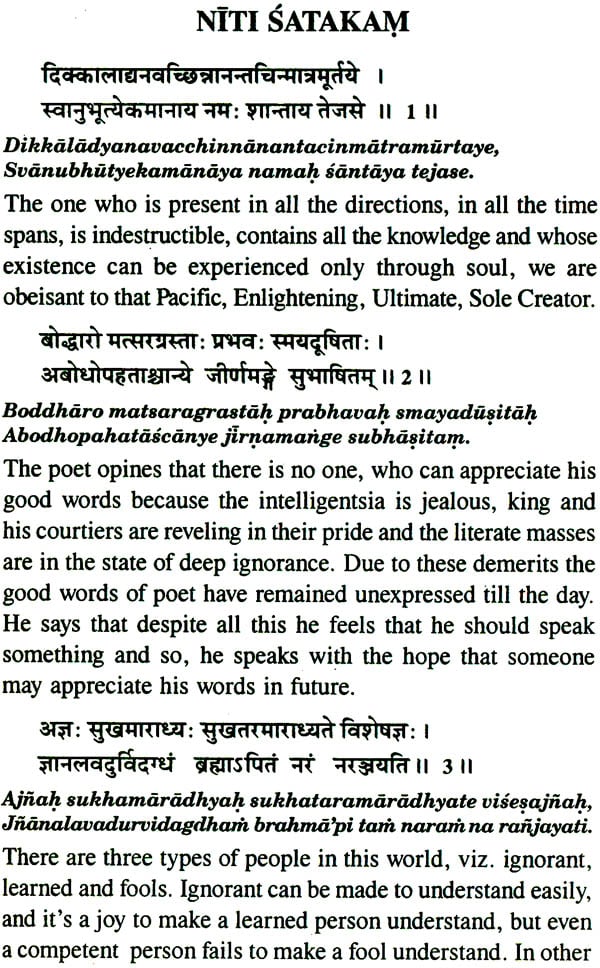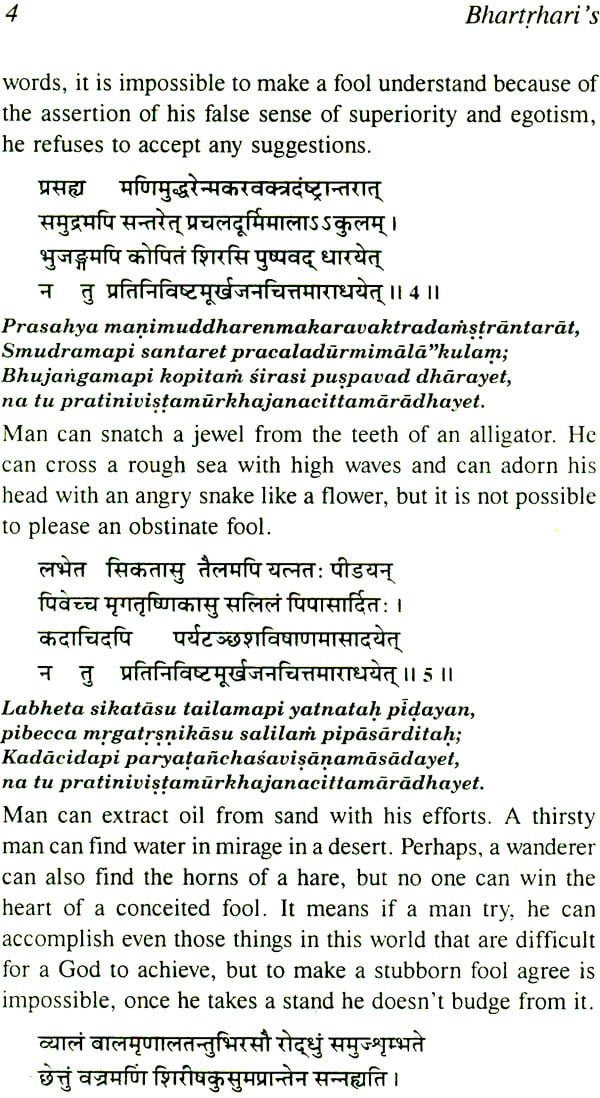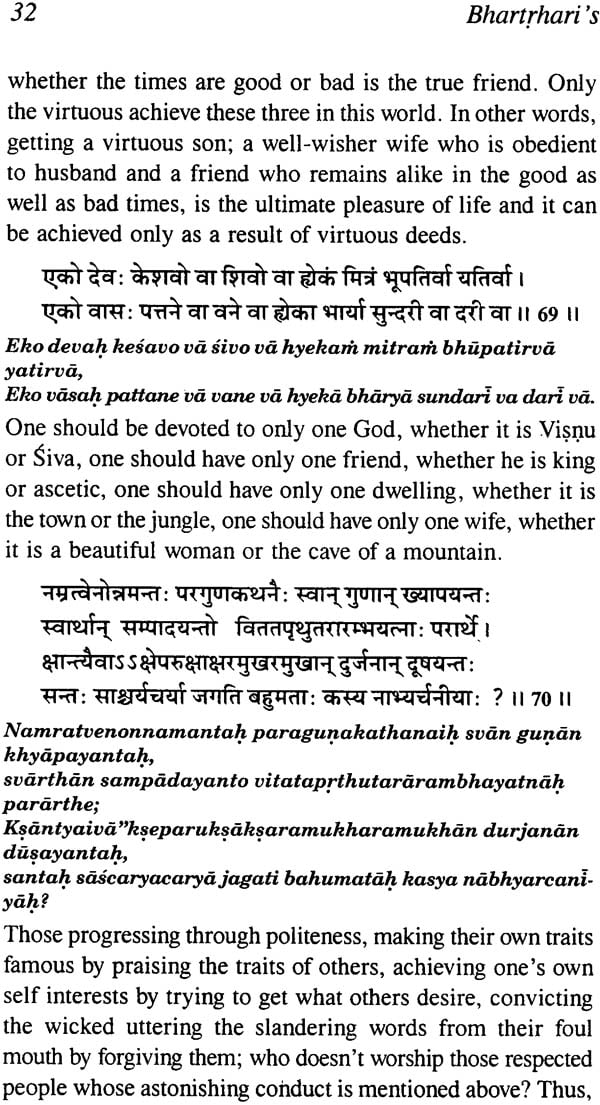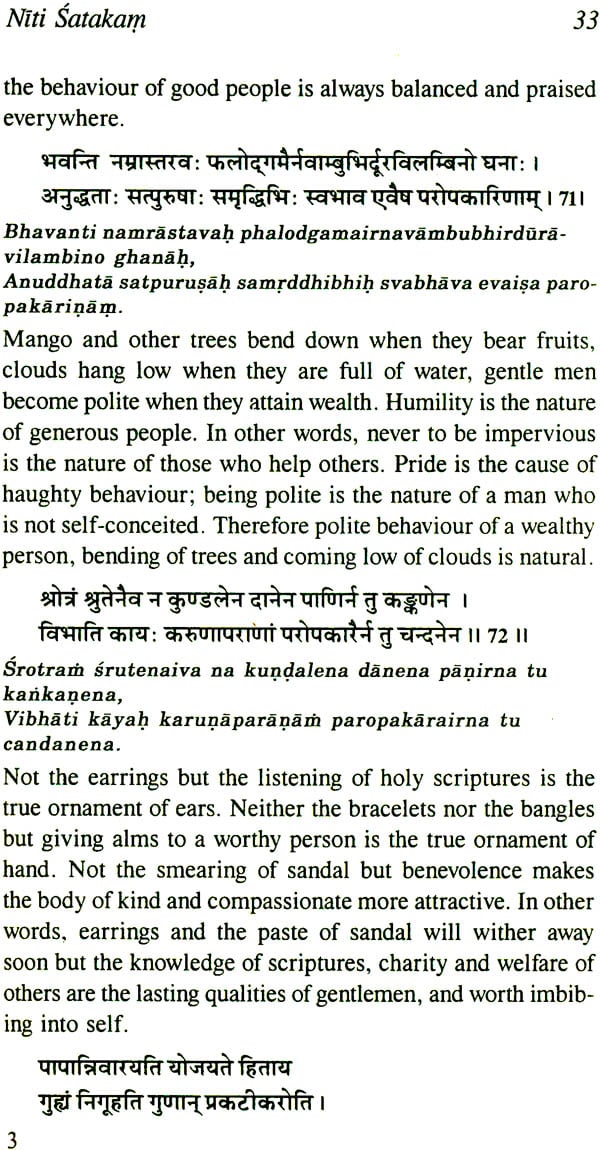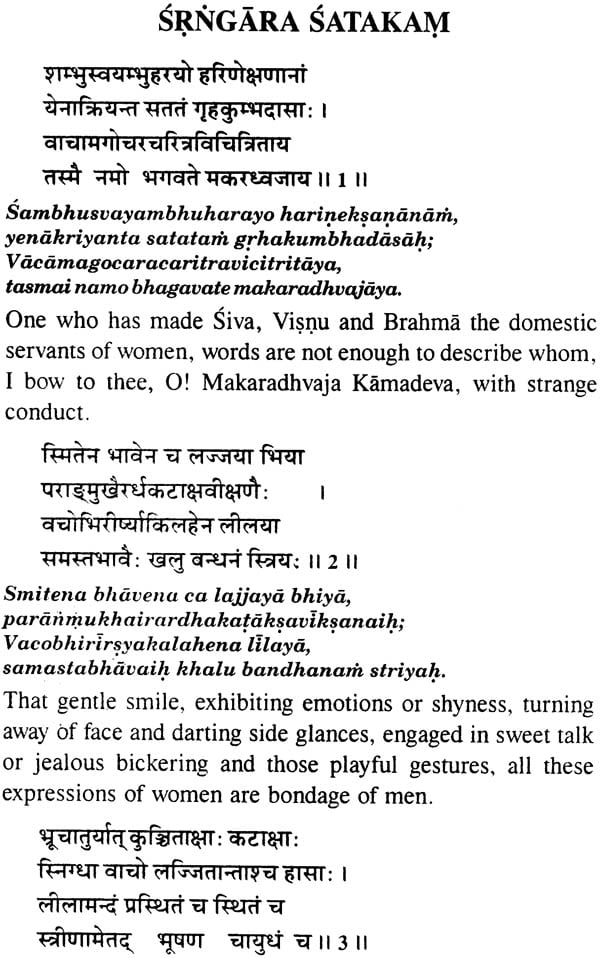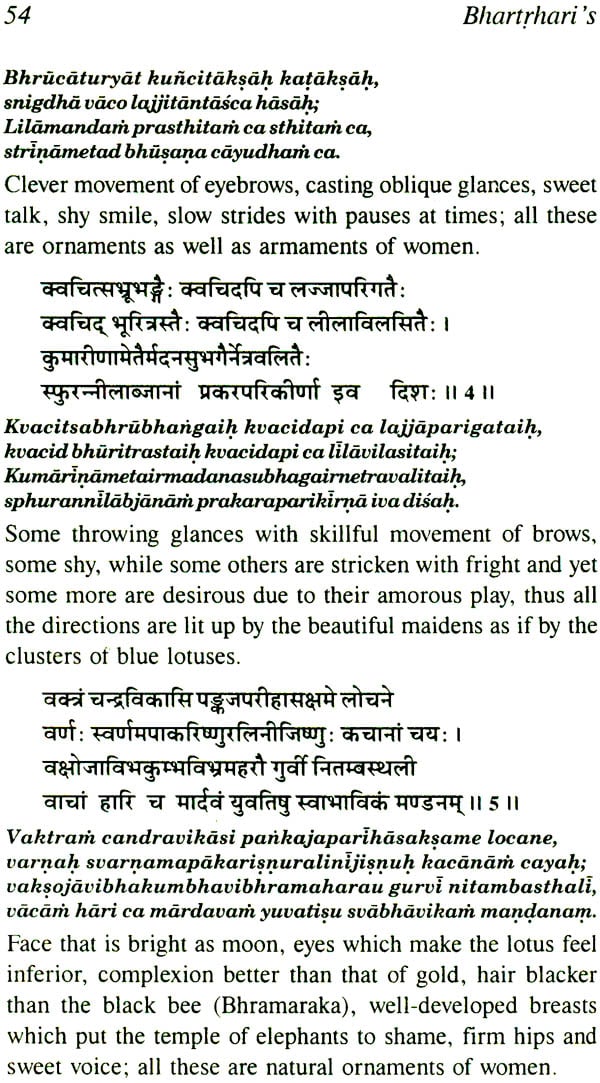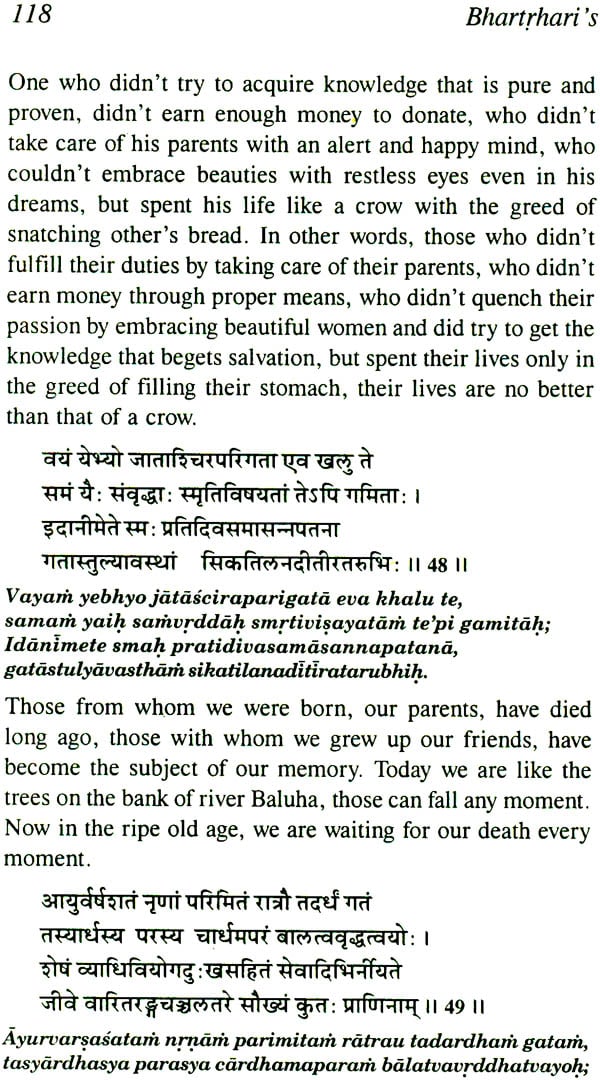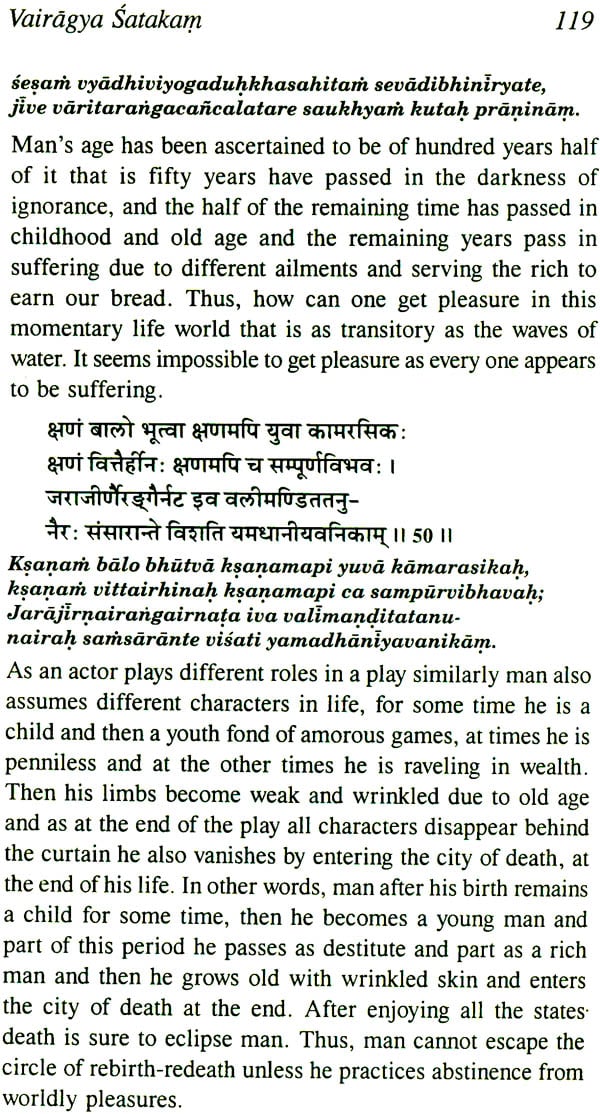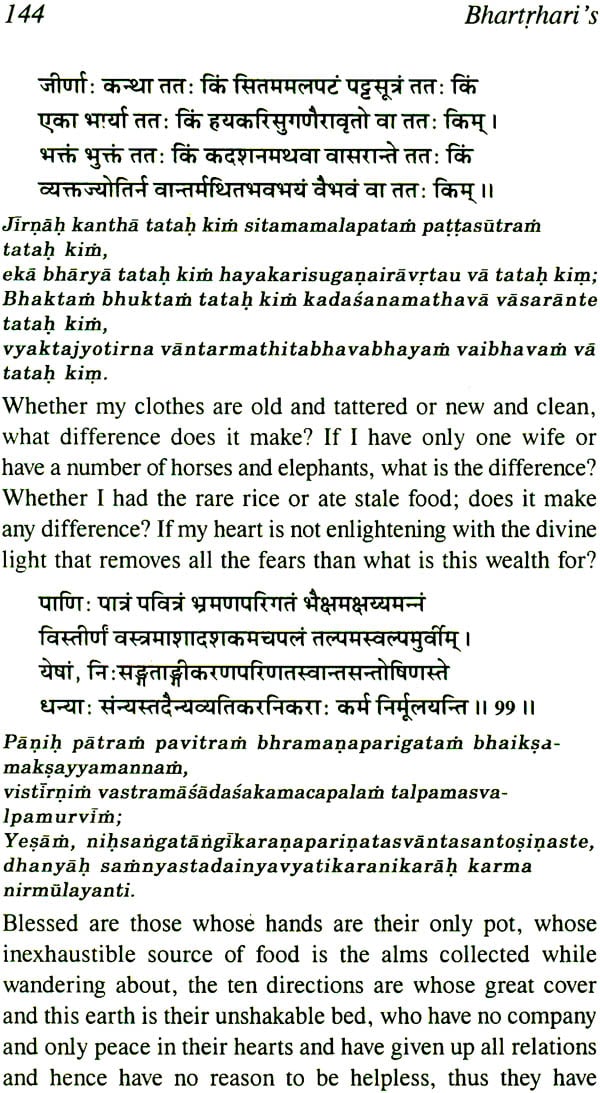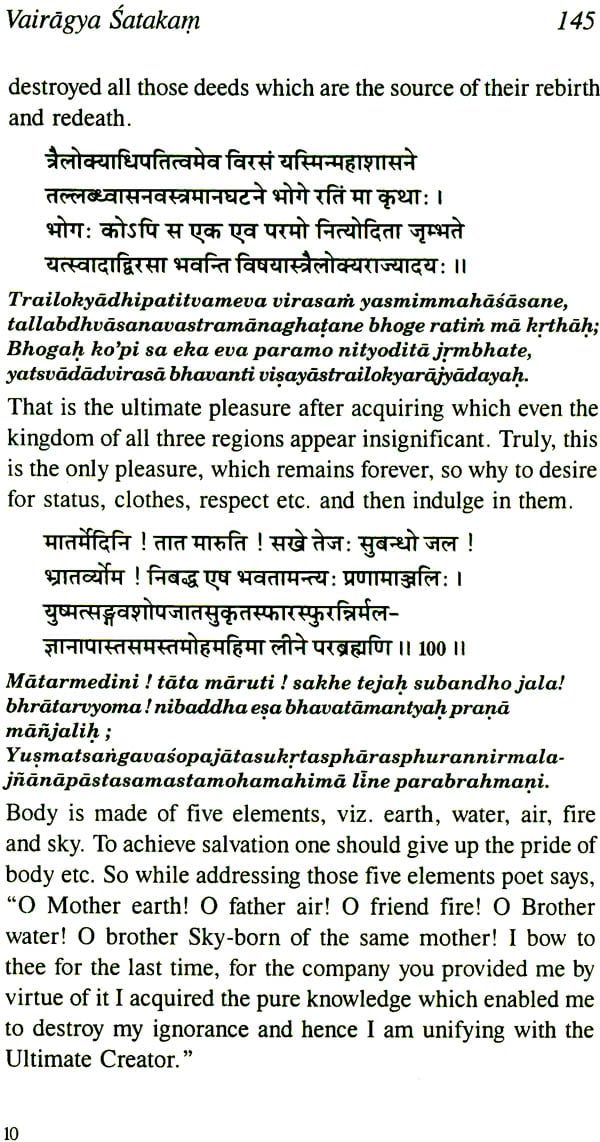
Bhartrhari's Satakatrayam (Niti, Srngara and Vairagya) (Sanskrit Text with Transliteration and English Translationh)
Book Specification
| Item Code: | NAE955 |
| Author: | Kamayani Mahodaya |
| Publisher: | Chaukhambha Publications |
| Language: | Sanskrit Text with Transliteration and English Translationh |
| Edition: | 2014 |
| Pages: | 164 |
| Cover: | Hardcover |
| Other Details | 9.0 inch X 6.0 inch |
| Weight | 330 gm |
Book Description
Like many other children I was also introduced to Sanskrit in sixth class. After the first few chapters about the basics of language and grammar, we had a lesson entitled ‘Nitisatakam’ which had ten verses. One of those, Yesam na vidya na tapo na danam jnanam na silam na guno na dharmah, Te matryaloke bhuvi bharabhuta manusyarupena mrgascaranti. I still remember. This sloka created a lasting impression on my young mind about the importance of knowledge and virtues, and I used it as a measure to judge people for a long time. In fact it has always encouraged me to learn more. Translating this treasure of simple but potent words has made me a greater fan of Bhartrhari. These verse not only help a person rationalize his problems but also motivate and encourage him to move on the right path. General wisdom and common sense propagated in these verse have not lost their significance even in today’s complex world. Bhartrhari is not a preacher, he is a practitioner. This fact is very much reflected in the erotic verses of Srigarasatakam. Each of these sloksas indicates his fondness for senuous living. His indulegence in amorous pleasures can be gauged by his description of the types of women or his comparison of seasons with those in love. All of these appear to be coming straight from his heart. Similar overwhelming thoughts and intense emotions can be seen in the slokas of Vairagyasatakam. These hundred verses portray his remorse and desire to renounce all worldly pleasures and immerse himself completely in pursuit of the ultimate. Certainly, all of these three hundred verses have something for everyone whether he is a young man of keen intellect or a mature adult or the one in his ripe old age.
For a common Indian, Bhartrhari is the true symbol of vairagya. He is known for his renunciation of all the worldly pleasures and turning to an ascetic life. He is believed to be a prominent follower of Advaita-vedanta and a great grammarian. Though much information is not available about the place and period in which he lived, but a careful study by historians indicates that probably there have been four persons at different places and periods who are know by the name “Bhartrhari”.
The first being Adi-Bhartrhari, who is said to be the follower of Sabdavaita school of thought. His period is believed to be from the fourth century of Vikramaditya to before Vikramaditya. He is considered to be the author of Vakyapadiyam, “Mahabhasyadipika”, “Satakatrayi”, “Sabdahatusamiksha” and “Dhatusamiksha”. He was a brahmin by birth and believed in the preaching of Vedas.
The second Bhartrhari is believed to have lived in Vallabhi, Gujarat. His period dates back to 660 to 667 of Vikram era, which coincides with the period of Sridhara Sen the third, who was the king of Vallabhi. He is famous for his work Bhattikavya which is penned by the name Bhattiswami.
According to available facts, the original name of third Bhartrhari was Vimalmati and he was Buddhist. He is believed to have written the book “Bhagvrati” and his period dates back to 701 to 705 of Vikram era. The famous Chinese traveller I-Ching has mentioned him as the creator of “Vakyadiyam” and a Buddhist, in his writings. It is understood that when I-ching was visiting India he must have heard of the death of Bhartrhari, the writer of Bhagvrati and took him for the being the writer of Vakyapadiyam, thus creating the myth that Bhartrhari was a Buddhist.
The fourth Bhartrhari is the proponent of “Vairagya patha” and a follower of Gorakanath. He is believed to be the wight of the nine Naths of Nathpantha. His period dates back to 12th century of Vikram era, which coincides with the period of king Vikramaditya of Chalukya dunasty. He is believed to have lives in Ujjain and written the book entitled Vairagyasatakam. He was a great siddha and a yogi. But as Pandit Hajariprasada Dwivedi has pointed out “Why has the author of Vairagyasatakam nowhere mentioned the mane of Gorakhanath, his guru, in his book? Also, it doesn’t appear that he has any knowledge of “Hatha-yoga” propagated by Gorakhanath.” These unanswered questions further vindicate the notion that Adi-Bhartrhari is the original author os Bhartrhari Satakatrya.
Notwithstanding these historic facts about Bhartrhari if we look at his writings they can undoubtedly be termed as the gem of ancient Sanskrit literature. The beauty of this literature lies in the use of independent completeness of the shloka that is marked by the essence and expression of a thought or a significant incident of life. Each sentiment has been expressed in such a way that it conveys its essential idea to the keen intelligentsia; and the wide, mature and well stored experience of age. This admirable quality of Sanskrit literature has taken the proportions of genius in case of Bhartrhari, as he has not only written with thought but also with emotion. This moved intellectuality of feeling and an intimate experience, give the potency and poignancy to his words.
It states that there are three types of people in this world, baseman, mediocre and the men of excellence and so are their behaviour. Base men fearing the obstacles are not able to start a work, mediocre start the work but stop in between, because they feel dejected due to the problems coming in the way; but the men of excellence complete the work despite being repeatedly attacked by the problems.
The next hundred verses entitled Srigarasatakam are known for the fiery love poetry. These were supposedly created when he was in his youth and immersed in love. These sentences are coated with highly erotic passion and indicate his passionate nature, preoccupation with the enjoyment of senses and the fact that he was a true lover.
Though on the surface Niti, Sringara and Vairagya appear to completely different and divergent to each other, but the truth is that they are the essential and complementary aspects of human life. The intrinsic divergence is only superficial. Pandit Hazariprasada Dwivedi has said, “Only a true lover can be the true ascetic.” Niti is the truth that bridges these two facets of life. This fact is very well apparent from the popular legend about the life of king Bhartrhari. According to which he was the king of Ujjain and elder brother of the famous king Vikramaditya. He was an able and loved king, and is said to be madly in love with his wife the queen Pingla. One day a saint gave him a fruit that he claimed would make its consumer immortal. King kept the fruit but instead of eating it himself, he decided to give it to his beloved queen. Nut the queen was not faithful to him, she was in love with caretaker of her stable, so she took the fruit from king and promised that she will eat it later but she gave it to her paramour. He in turn was in love with a prostitute and so gifted that fruit to her. This lowly woman thought that the fruit was of no use to her as the immortality will only add to her sufferings, bring her more pain, so she decided that the able and large hearted king was fit for that fruit. Next day she went to the court and offered it to King Bhartrhari who was shocked to see it. Revelation of truth frustrated him and ended his enchantment with everything around him. The pain of deceit put him on the path of Vairagya renouncing all that he had.
The most remarkable thing about Bhartrhari is that his detachment with the material life was not cause by the dullness of senses or as a foudness for the monastic life rather it was born of the pain and suffering he received from his beloved. According to I-ching he attempted to take up the life of an ascetic seven times but every time he failed due to his attraction to sensuous living. Thus, after a long self-struggle he was able to control his desires and become a yogi. This may be yet another of many myths about Bhartrhari but it certainly points that intellectually he had understood the transitory nature of worldly pleasures and felt a call to ascetic living. It also tells about his carefree and wandering nature. Apparently he was capable of enjoying everything that life had offered him. The legends about his life are a showcase of diverse experiences of life. This quality of his is reflected in his writing as well thus making them full of the essence of life that can be enjoyed by readers even in times to come.
